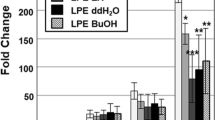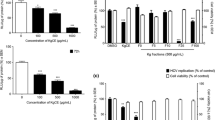Abstract
Hepatitis E virus (HEV) is an etiological agent of acute hepatitis E, a self-limiting disease prevalent in develo** countries. HEV can cause fulminant hepatic failure with high mortality rates in pregnant women, and genotype 3 is reported to trigger chronic hepatitis in immunocompromised individuals worldwide. Screening of plant extracts for compounds with potential anti-HEV effects led to the identification of a 70% ethanol extract of Lysimachia mauritiana (LME) that interferes with replication of the swine HEV genotype 3 replicon. Furthermore, LME significantly inhibited replication of HEV genotype 3 and expression of HEV ORF2 in infected cells without exerting cytotoxic effects. Collectively, our findings demonstrate the potential utility of LME in the development of novel antiviral drugs against HEV infection.
Similar content being viewed by others
References
Abdelmohsen, U.R., Balasubramanian, S., Oelschlaeger, T.A., Grkovic, T., Pham, N.B., Quinn, R.J., and Hentschel, U. 2017. Potential of marine natural products against drug-resistant fungal, viral, and parasitic infections. Lancet Infect. Dis. 17, e30–e41.
Aggarwal, R. and Naik, S.R. 1994. Hepatitis E: intrafamilial transmission versus waterborne spread. J. Hepatol. 21, 718–723.
Bae, S. and Song, Y.J. 2017. Inhibition of varicellazoster virus replication by an ethanol extract of Lysimachia mauritiana. Mol. Med. Rep. 15, 3847–3851.
Begum, N., Devi, S.G., Husain, S.A., Ashok, K., and Kar, P. 2009. Seroprevalence of subclinical HEV infection in pregnant women from north India: a hospital based study. Indian J. Med. Res. 130, 709–713.
Bose, P.D., Das, B.C., Kumar, A., Gondal, R., Kumar, D., and Kar, P. 2011. High viral load and deregulation of the progesterone receptor signaling pathway: association with hepatitis E-related poor pregnancy outcome. J. Hepatol. 54, 1107–1113.
Cao, D. and Meng, X.J. 2012. Molecular biology and replication of hepatitis E virus. Emerg. Microbes Infect. 1, e17.
Chandra, V., Kalia, M., Hajela, K., and Jameel, S. 2010. The ORF3 protein of hepatitis E virus delays degradation of activated growth factor receptors by interacting with CIN85 and blocking formation of the Cbl-CIN85 complex. J. Virol. 84, 3857–3867.
Clayson, E.T., Innis, B.L., Myint, K.S.A., Narupiti, S., Vaughn, D.W., Giri, S., Ranabhat, P., and Shrestha, M.P. 1995. Detection of hepatitis E virus infections among domestic swine in the Kathmandu Valley of Nepal. Am. J. Trop. Med. Hyg. 53, 228–232.
Debing, Y., Emerson, S.U., Wang, Y., Pan, Q., Balzarini, J., Dallmeier, K., and Neyts, J. 2014. Ribavirin inhibits in vitro hepatitis E virus replication through depletion of cellular GTP pools and is moderately synergistic with alpha interferon. Antimicrob. Agents Chemother. 58, 267–273.
Dell’Amico, M.C., Cavallo, A., Gonzales, J.L., Bonelli, S.I., Valda, Y., Pieri, A., Segundo, H., Ibañez, R., Mantella, A., and Bartalesi, F. 2011. Hepatitis E virus genotype 3 in humans and Swine, Bolivia. Emerg. Infect. Dis. 17, 1488.
Emerson, S.U. and Purcell, R.H. 2003. Hepatitis E virus. Rev. Med. Virol. 13, 145–154.
Gérolami, R., Moal, V., and Colson, P. 2008. Chronic hepatitis E with cirrhosis in a kidney-transplant recipient. N. Engl. J. Med. 358, 859–860.
Graff, J., Torian, U., Nguyen, H., and Emerson, S.U. 2006. A bicistronic subgenomic mRNA encodes both the ORF2 and ORF3 proteins of hepatitis E virus. J. Virol. 80, 5919–5926.
He, M., Wang, M., Huang, Y., Peng, W., Zheng, Z., **a, N., Xu, J., and Tian, D. 2016. The ORF3 protein of genotype 1 hepatitis E virus suppresses TLR3-induced NF-kappaB signaling via TRADD and RIP1. Sci. Rep. 6, 27597.
Huang, Y., Opriessnig, T., Halbur, P., and Meng, X. 2007. Initiation at the third in-frame AUG codon of open reading frame 3 of the hepatitis E virus is essential for viral infectivity in vivo. J. Virol. 81, 3018–3026.
Huang, F., Pierson, F., Toth, T., and Meng, X. 2005. Construction and characterization of infectious cDNA clones of a chicken strain of hepatitis E virus (HEV), avian HEV. J. Gen. Virol. 86, 2585–2593.
Johne, R., Reetz, J., Ulrich, R., Machnowska, P., Sachsenröder, J., Nickel, P., and Hofmann, J. 2014. An ORF1‐rearranged hepatitis E virus derived from a chronically infected patient efficiently replicates in cell culture. J. Viral. Hepat. 21, 447–456.
Kalia, M., Chandra, V., Rahman, S.A., Sehgal, D., and Jameel, S. 2009. Heparan sulfate proteoglycans are required for cellular binding of the hepatitis E virus ORF2 capsid protein and for viral infection. J. Virol. 83, 12714–12724.
Kamar, N., Bendall, R., Legrand-Abravanel, F., **a, N.S., Ijaz, S., Izopet, J., and Dalton, H.R. 2012. Hepatitis E. Lancet 379, 2477–2488.
Khuroo, M.S., Kamali, S., and Jameel, S. 1995. Vertical transmission of hepatitis E virus. Lancet 345, 1025–1026.
Larralde, O. and Petrik, J. 2017. Phage-displayed peptides that mimic epitopes of hepatitis E virus capsid. Med. Microbiol. Immunol. 206, 301–309.
Meng, X. 2010. Hepatitis E virus: animal reservoirs and zoonotic risk. Vet. Microbiol. 140, 256–265.
Moin, S.M., Chandra, V., Arya, R., and Jameel, S. 2009. The hepatitis E virus ORF3 protein stabilizes HIF‐1α and enhances HIF-1α mediated transcriptional activity through p300/CBP. Cell Microbiol. 11, 1409–1421.
Nan, Y. and Zhang, Y.J. 2016. Molecular Biology and Infection of Hepatitis E Virus. Front. Microbiol. 7, 1419.
Navaneethan, U., Al Mohajer, M., and Shata, M.T. 2008. Hepatitis E and pregnancy: understanding the pathogenesis. Liver Int. 28, 1190–1199.
Patra, S., Kumar, A., Trivedi, S.S., Puri, M., and Sarin, S.K. 2007. Maternal and fetal outcomes in pregnant women with acute hepatitis E virus infection maternal and fetal outcomes in HEVInfected pregnant women. Ann. Intern. Med. 147, 28–33.
Pischke, S., Hardtke, S., Bode, U., Birkner, S., Chatzikyrkou, C., Kauffmann, W., Bara, C.L., Gottlieb, J., Wenzel, J., Manns, M.P., et al. 2013. Ribavirin treatment of acute and chronic hepatitis E: a single-centre experience. Liver Int. 33, 722–726.
Schemmerer, M., Apelt, S., Trojnar, E., Ulrich, R.G., Wenzel, J.J., and Johne, R. 2016. Enhanced replication of hepatitis E virus strain 47832c in an A549-derived subclonal cell line. Viruses 8, 267.
Schlosser, B., Stein, A., Neuhaus, R., Pahl, S., Ramez, B., Krüger, D., Berg, T., and Hofmann, J. 2012. Liver transplant from a donor with occult HEV infection induced chronic hepatitis and cirrhosis in the recipient. J. Hepatol. 56, 500–502.
Shrestha, A.C., Flower, R.L., Seed, C.R., Keller, A.J., Hoad, V., Harley, R., Leader, R., Polkinghorne, B., Furlong, C., and Faddy, H.M. 2017. Hepatitis E virus infections in travellers: assessing the threat to the Australian blood supply. Blood Transfus. 15, 191.
Tam, A.W., Smith, M.M., Guerra, M.E., Huang, C.C., Bradley, D.W., Fry, K.E., and Reyes, G.R. 1991. Hepatitis E virus (HEV): molecular cloning and sequencing of the full-length viral genome. Virology 185, 120–131.
Tang, X., Yang, C., Gu, Y., Song, C., Zhang, X., Wang, Y., Zhang, J., Hew, C.L., Li, S., and **a, N. 2011. Structural basis for the neutralization and genotype specificity of hepatitis E virus. Proc. Natl. Acad. Sci. USA 108, 10266–10271.
Teshale, E.H., Grytdal, S.P., Howard, C., Barry, V., Kamili, S., Drobeniuc, J., Hill, V.R., Okware, S., Hu, D.J., and Holmberg, S.D. 2010. Evidence of person-to-person transmission of hepatitis E virus during a large outbreak in Northern Uganda. Clin. Infect. Dis. 50, 1006–1010.
Van der Poel, W.H. 2014. Food and environmental routes of Hepatitis E virus transmission. Curr. Opin. Virol. 4, 91–96.
Yamada, K., Takahashi, M., Hoshino, Y., Takahashi, H., Ichiyama, K., Nagashima, S., Tanaka, T., and Okamoto, H. 2009. ORF3 protein of hepatitis E virus is essential for virion release from infected cells. J. Gen. Virol. 90, 1880–1891.
Yasukawa, K., Ogawa, H., and Takido, M. 1990. Studies of the constituents of genus lysimachia.5. 2 flavonol glycosides from lysimachia-nummularia. Phytochemistry 29, 1707–1708.
Yasukawa, K. and Takido, M. 1986. Studies on the chemical constituents of genus lysimachia i. on the whole parts of Lysimachia japonica and Lysimachia clethroides. Yakugaku Zasshi 106, 939–941.
Zhu, F.C., Zhang, J., Zhang, X.F., Zhou, C., Wang, Z.Z., Huang, S.J., Wang, H., Yang, C.L., Jiang, H.M., and Cai, J.P. 2010. Efficacy and safety of a recombinant hepatitis E vaccine in healthy adults: a large-scale, randomised, double-blind placebo-controlled, phase 3 trial. Lancet 376, 895–902.
Author information
Authors and Affiliations
Corresponding author
Rights and permissions
About this article
Cite this article
**, S.E., Kim, JE., Kim, S.Y. et al. An ethanol extract of Lysimachia mauritiana exhibits inhibitory activity against hepatitis E virus genotype 3 replication. J Microbiol. 55, 984–988 (2017). https://doi.org/10.1007/s12275-017-7477-1
Received:
Revised:
Accepted:
Published:
Issue Date:
DOI: https://doi.org/10.1007/s12275-017-7477-1




